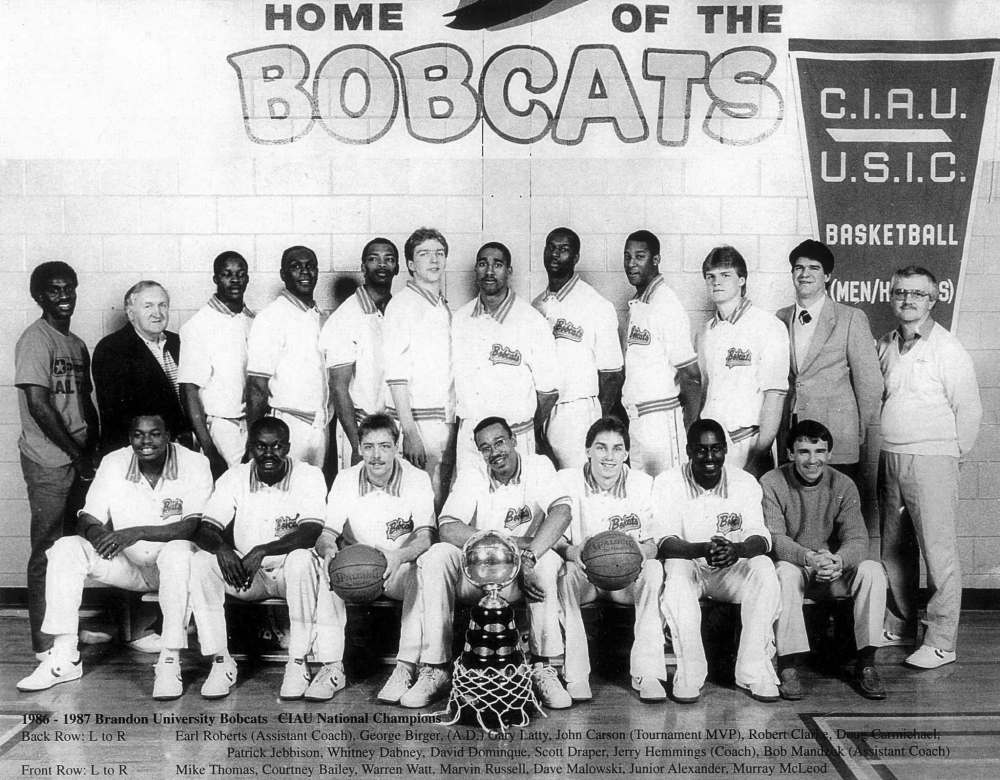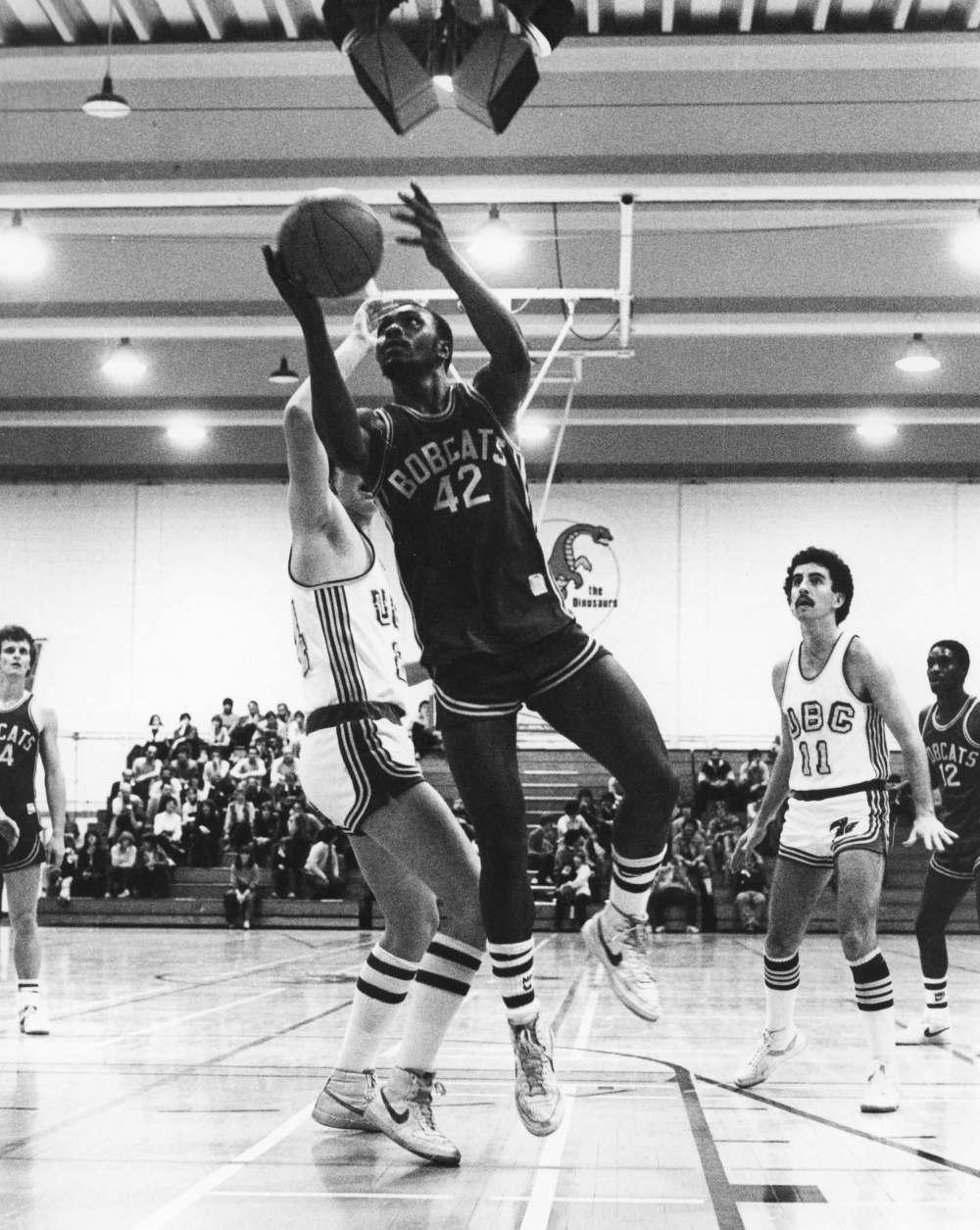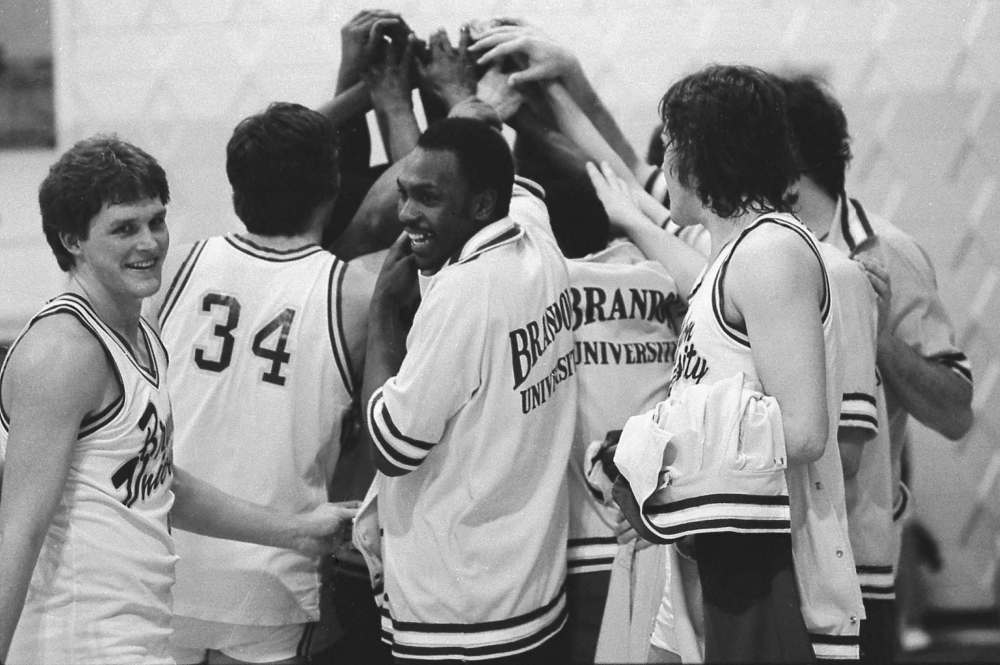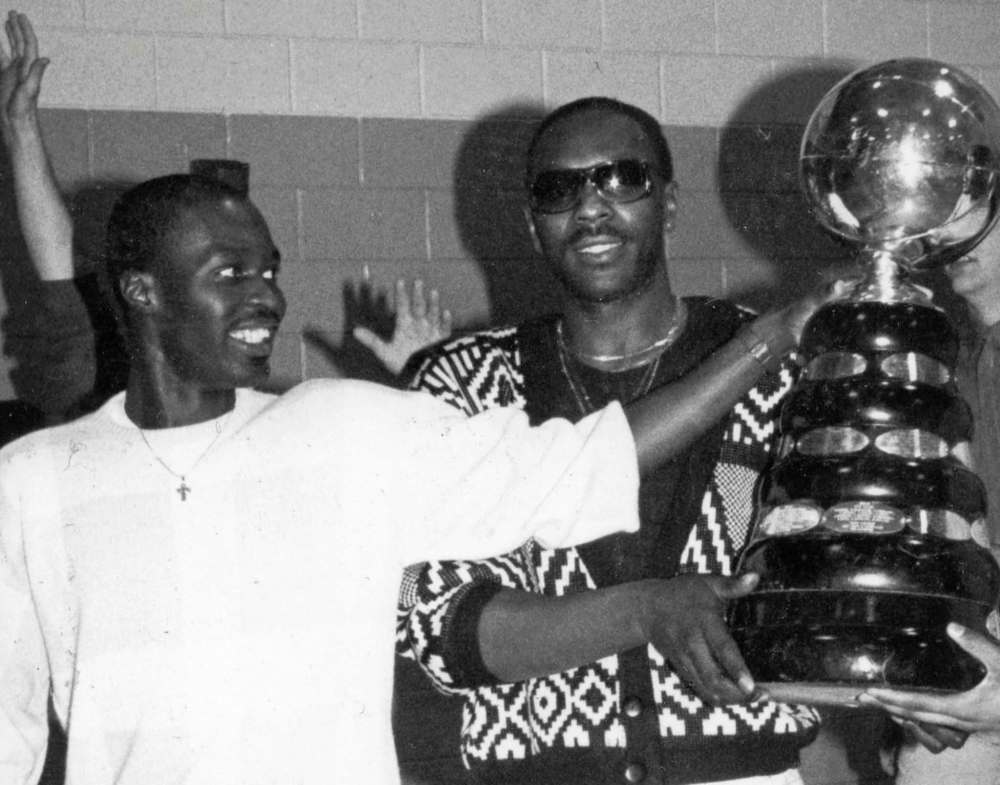Starting to make history
Brandon University's 1987 championship basketball team was first to start five Black players in title game
Advertisement
Read this article for free:
or
Already have an account? Log in here »
To continue reading, please subscribe:
Monthly Digital Subscription
$0 for the first 4 weeks*
- Enjoy unlimited reading on winnipegfreepress.com
- Read the E-Edition, our digital replica newspaper
- Access News Break, our award-winning app
- Play interactive puzzles
*No charge for 4 weeks then price increases to the regular rate of $19.00 plus GST every four weeks. Offer available to new and qualified returning subscribers only. Cancel any time.
Monthly Digital Subscription
$4.75/week*
- Enjoy unlimited reading on winnipegfreepress.com
- Read the E-Edition, our digital replica newspaper
- Access News Break, our award-winning app
- Play interactive puzzles
*Billed as $19 plus GST every four weeks. Cancel any time.
To continue reading, please subscribe:
Add Free Press access to your Brandon Sun subscription for only an additional
$1 for the first 4 weeks*
*Your next subscription payment will increase by $1.00 and you will be charged $16.99 plus GST for four weeks. After four weeks, your payment will increase to $23.99 plus GST every four weeks.
Read unlimited articles for free today:
or
Already have an account? Log in here »
Hey there, time traveller!
This article was published 11/02/2021 (1763 days ago), so information in it may no longer be current.

When the Brandon University Bobcats men’s basketball team won the national championship in 1987, the majority of the team wasn’t aware that they had made Canadian history.
Twenty-one years after Texas Western became the first basketball team to start five Black players in an NCAA championship game, Brandon became the first Canadian university to start five Black players in the CIAU (now U Sports) men’s basketball gold medal game. Head coach Jerry Hemmings’ starting lineup of point guard Courtney Bailey, shooting guard Marvin Russell, small forward Patrick Jebbison, power forward John Carson, and centre Whitney Dabney defeated the UBC Thunderbirds 74-66 in Halifax, N.S., to become only the second Manitoba team to be crowned the country’s best university men’s basketball team (the Manitoba Bisons were the first in 1976).
Their similarities to the well-documented Texas Western story (Texas Western beat Kentucky 72-65 in the title game) wasn’t brought to the attention of some of the players involved until the ‘87 squad, as well as Brandon’s ‘88 and ‘89 national championship teams, were inducted into the Manitoba Sports Hall of Fame in 2019.
But it wasn’t news to Bailey, a five-year player out of Toronto who was known as the team’s ‘backbone of the backcourt.’ Bailey was also a member of the ‘88 title team.

“We were doing something that had not been done before. I had studied it enough, I was a history major so I knew what we were embarking on. But I didn’t want to bring a lot of light to it because I just thought at the time ‘You know what, a small university in the Prairies winning a national championship is historical enough,’” Bailey, who’s now a school principal in Cairo, Egypt, said in a phone interview.
“I was satisfied with that… For us, we just felt like we’re just a team in the championship. It was later on we started talking about it. A couple years ago we’re at the hall of fame ceremony in Winnipeg and I remember sitting there talking to my teammates about it and they’re ‘Huh? Are you serious?’ And I said ‘Yeah! We’re like the university in (Texas Western) that won.’ I guess it never really dawned on any of us at that time.”
In 2006, Disney released a movie based on Texas Western’s historic run called Glory Road. Of course, the times and circumstances were much different, but you won’t find any mention of Brandon’s Black starting five in the ‘87 final anywhere online. But that’s not necessarily a bad thing. The fact that nobody thought anything of it at the time might just be the best part of the story.
“People remember that we were all good, but we were like everybody else,” said Earl Roberts, an assistant coach on the ‘87 team. Roberts, who now lives in Winnipeg and referees U Sports basketball, also came to Brandon from Toronto and was the team’s star point guard from 1980-85.
“We put our socks on the same way. Don’t look at us as Black, white, red, or green because we’re humans. Everybody deserves a fair shake and we all got it. We all treated everybody the same way.”
What didn’t go unnoticed though was how Carson dominated UBC. The five-time all-Canadian was a senior and saved arguably his best performance for last as he led the way with 38 points and was named the tournament MVP. Carson, a native of Huntsville, N.C., put an exclamation mark on the game, and his university career, with a steal and one-handed slam in the final seconds. The Victoria Vikes had won the previous seven national titles and even though the Bobcats were losing Carson, it was the start of a new dynasty.

“It was very important because it was the last kick at the can (for me),” said Carson, who now resides in Calgary.
“Obviously, you’re nervous because it’s the last of your career and you want to go out on top. It was pretty nerve-racking, but it was fun.”
It was also only the beginning for Carson as he went on to play in the World Basketball League (which featured the Winnipeg Thunder) for both the Saskatchewan Storm and the Calgary 88’s before continuing his career in Europe. But even with his long basketball resumé, Carson’s time in the Wheat City is at the top of his list.
“The people of Brandon, I couldn’t have been treated any better,” Carson said. Before the pandemic hit, Carson and his university teammates were planning a reunion in Brandon. “Even to this day, I usually go there two or three times a year… Brandon always holds a dear spot in my heart. Always.”

Carson was one of two American starters for Brandon that season with Dabney, a New Orleans, La., native, being the other. Mike Thomas, a shooting guard from Winston-Salem, N.C., was the team’s first option off the bench. Even though schools were only allowed to have three imports on a team, many people assumed and/or implied that the Bobcats were made up of American players due to their roster mostly consisting of Black players.
“We played Winnipeg in the (Great Plains Athletic Conference) championship game and whenever they introduced one of my players, they flashed the American flag on their scoreboard screen,” said Hemmings, a North Carolina native who coached the Bobcats from 1974-2004, winning a total of four national titles. Hemmings still lives in Brandon today.
“I think it was a situation where basically they were trying to send a message. ‘We have five white players playing and Brandon is playing five Black Americans.’ That was the message they were trying to send a way to get their fans into it. Looking back, it probably even made us more focused, especially for some of the (Canadian) players.”
The Bobcats beat the Winnipeg Wesmen 100-88 that night to win the GPAC banner and advance to nationals.
Hemmings built a reputation for recruiting many Americans to the Keystone Province over the years, but the program’s success, especially in the late ‘80s, wouldn’t be possible without talent from the Great White North. He points to Jebbison, who now lives in England, as a prime example. Jebbison, a product of Etobicoke, Ont., was a force on all three gold medal teams and was the CIAU Player of the Year in ‘88 and ‘89.
“Our American players helped us become competitive, but we won because of our Canadians,” said Hemmings.
Bailey, and his fellow Ontarians in Russell and Jebbison, were no strangers to people assuming they were from south of the border.
“When people talked about Black basketball players, they thought of the U.S., not Canada… But I think it went with the times, I mean, it was the ‘80s. Basketball wasn’t that big in Canada. We didn’t have the Raptors, we didn’t have the Grizzlies, so university was as big as it got,” Bailey said.
“Yes, we did have Americans on the team and I think people just assumed ‘Oh, they’re Black, they have to be from America.’ It was just the nature of what it was. We didn’t take it for anything. We kind of just went out there and wanted to play basketball.”
Whether they were American or Canadian, Black or white, it doesn’t matter. A small Manitoba school ruling the Canadian hardwood for three straight years is a feat that will likely never be duplicated.
“I just want them to remember that the team was made up of Canadian basketball players as well as Americans. We were kind of the trendsetters for Canadian university basketball as far as making it popular and making it important for Black players to stay at home and not try to go to universities in the States,” Bailey said.
“I think we kind of paved the way as Black Canadian athletes to say ‘It’s OK to stay here and play basketball.’ The level of basketball has grown tremendously, not only in university but also in high school, and with the professional teams being in the country now, I think it added tremendous growth for basketball. But somewhere along the line, there were a group of young men who actually went to a small town in the midwest and made basketball popular there and very successful.”
taylor.allen@freepress.mb.ca
Twitter: @TaylorAllen31

Taylor Allen is a sports reporter for the Winnipeg Free Press. Taylor was the Vince Leah intern in the Free Press newsroom twice while earning his joint communications degree/diploma at the University of Winnipeg and Red River College Polytechnic. He signed on full-time in 2019 and mainly covers the Blue Bombers, curling, and basketball. Read more about Taylor.
Every piece of reporting Taylor produces is reviewed by an editing team before it is posted online or published in print — part of the Free Press‘s tradition, since 1872, of producing reliable independent journalism. Read more about Free Press’s history and mandate, and learn how our newsroom operates.
Our newsroom depends on a growing audience of readers to power our journalism. If you are not a paid reader, please consider becoming a subscriber.
Our newsroom depends on its audience of readers to power our journalism. Thank you for your support.
History
Updated on Thursday, February 11, 2021 8:11 PM CST: Fixes formatting.
Updated on Thursday, February 11, 2021 8:18 PM CST: Fixes typo.
Updated on Thursday, February 11, 2021 9:29 PM CST: Fixes points number


